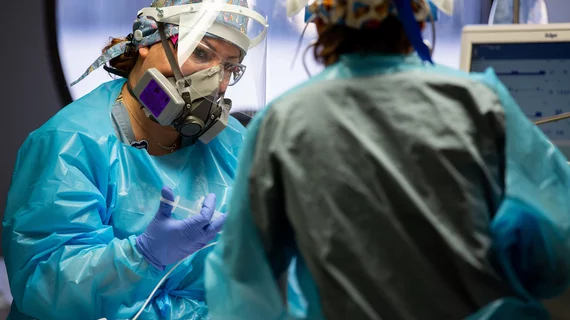Losartan fails to improve lung injuries in hospitalized COVID-19 patients
Treatment with losartan does not reduce lung injuries or improve any clinical incomes among hospitalized COVID-19 patients, according to a new analysis published in JAMA Network Open.[1]
In fact, the study’s authors wrote, losartan “raised concerns about risks of harm” after comparing unfavorably to a placebo.
Researchers conducted a small randomized clinical trial at 13 different U.S. hospitals from April 2020 to February 2021. All patients had a confirmed COVID-19 diagnosis and showed signs of at least one CDC-recognized symptom. Outpatients treated with an angiotensin-converting enzyme (ACE) inhibitor or angiotensin receptor blocker (ARB) were excluded.
Losartan, a popular ARB commonly used to treat hypertension and heart failure, was given orally to 101 patients twice daily for 10 days or until hospital discharge. Another 104 patients were given a placebo. The overall mean age was 55.2 years old, and 60% of patients were men.
Overall, based on each patient’s ratio of arterial oxygen partial pressure (PaO2) to fractional inspired oxygen (FiO2), treatment with losartan was not associated with any lung injury improvements after seven days. There was also no difference in lengths of stay, in-hospital mortality or freedom from mechanical ventilation between the losartan group and the placebo group.
However, more patients from the losartan group (20%) required a vasopressor than the placebo group (10.7%). More drug-related cardiovascular adverse events were also seen in the losartan group, but the difference was not great enough to be considered significant. Acute kidney injury was also more likely in patients from the losartan group (19.4%) than the placebo group (8.8%).
“It is important to note that we observed two potentially harmful effects of losartan on hemodynamics and kidney function,” wrote lead author Michael A. Puskarich, MD, MS, an emergency medicine specialist at the University of Minnesota, and colleagues. “However, a higher proportion of participants in the intervention group were enrolled in the ICU, indicating potential small imbalances in severity of illness at enrollment. Generally, patients requiring the ICU are characterized by older age, are more likely to be a race other than White and to be men, and have more comorbidities.”
Puskarich et al. concluded that oral losartan provided no value to hospitalized COVID-19 patients when looking at either acute lung injury or other clinical outcomes.
Related COVID-19 Content:
‘We learned that lung recovery was actually possible’: ECMO’s impact on COVID-19 patients in the ICU
Telehealth provided value for heart failure patients during COVID-19 pandemic
Congenital heart disease increases risk of poor COVID-19 outcomes, including death
How COVID-19 vaccination affects the risk of ED visits for cardiac, respiratory issues
Reference:

